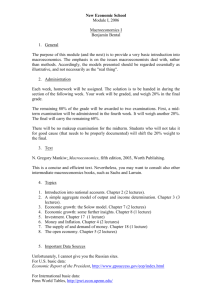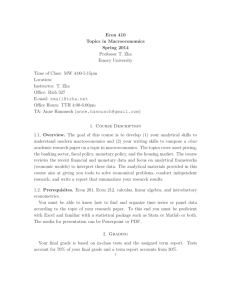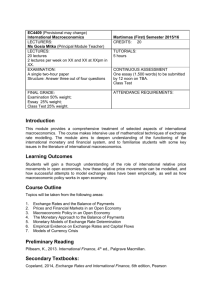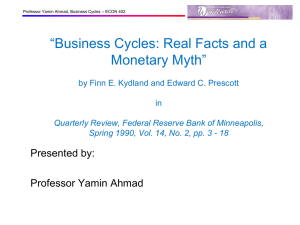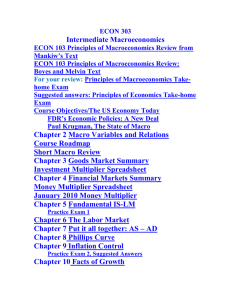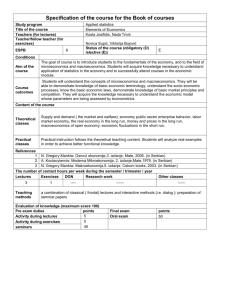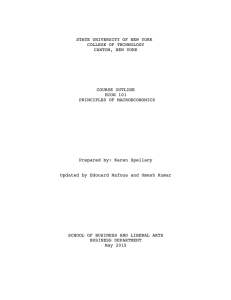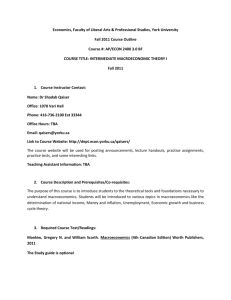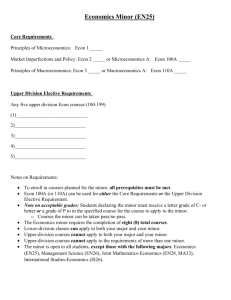Document 10316248
advertisement
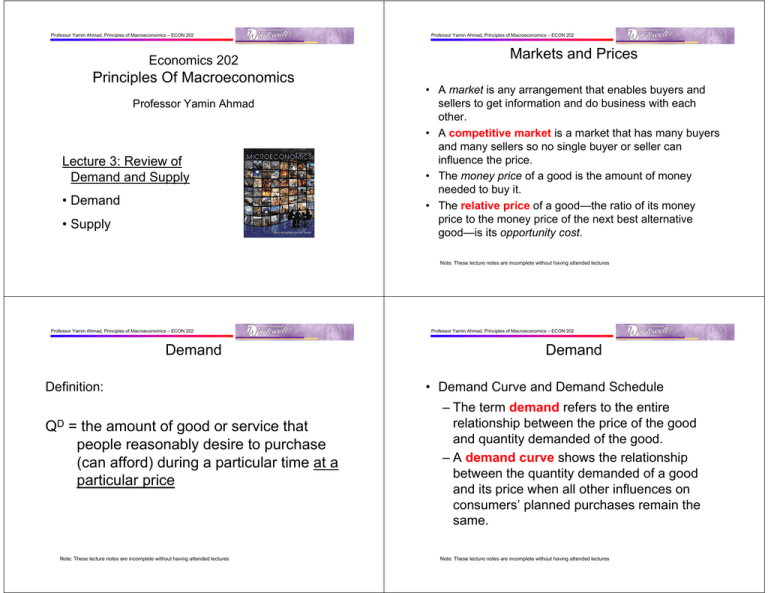
Professor Yamin Ahmad, Principles of Macroeconomics – ECON 202 Economics 202 Professor Yamin Ahmad, Principles of Macroeconomics – ECON 202 Markets and Prices Principles Of Macroeconomics Professor Yamin Ahmad Lecture 3: Review of Demand and Supply • Demand • Supply • A market is any arrangement that enables buyers and sellers to get information and do business with each other. • A competitive market is a market that has many buyers and many sellers so no single buyer or seller can influence the price. • The money price of a good is the amount of money needed to buy it. • The relative price of a good—the ratio of its money price to the money price of the next best alternative good—is its opportunity cost. Note: These lecture notes are incomplete without having attended lectures Professor Yamin Ahmad, Principles of Macroeconomics – ECON 202 Demand Definition: QD = the amount of good or service that people reasonably desire to purchase (can afford) during a particular time at a particular price Note: These lecture notes are incomplete without having attended lectures Professor Yamin Ahmad, Principles of Macroeconomics – ECON 202 Demand • Demand Curve and Demand Schedule – The term demand refers to the entire relationship between the price of the good and quantity demanded of the good. – A demand curve shows the relationship between the quantity demanded of a good and its price when all other influences on consumers’ planned purchases remain the same. Note: These lecture notes are incomplete without having attended lectures Professor Yamin Ahmad, Principles of Macroeconomics – ECON 202 Professor Yamin Ahmad, Principles of Macroeconomics – ECON 202 Example: CD-R Sales Quantity(QD;) 9 6 4 3 2 Price(P) $ 0.50 1.00 1.50 2.00 2.50 The Demand Curve Demand Schedule D Note: These lecture notes are incomplete without having attended lectures Professor Yamin Ahmad, Principles of Macroeconomics – ECON 202 Professor Yamin Ahmad, Principles of Macroeconomics – ECON 202 The “Law” of Demand Price (P) D Note: These lecture notes are incomplete without having attended lectures The higher the price of the good, the smaller the quantity demanded (QD), ceteris paribus Demand • The Law of Demand results from – a substitution effect – an income effect Quantity (QD) Note: These lecture notes are incomplete without having attended lectures Note: These lecture notes are incomplete without having attended lectures Professor Yamin Ahmad, Principles of Macroeconomics – ECON 202 Demand • Substitution effect — when the relative price (opportunity cost) of a good or service rises, people seek substitutes for it, so the quantity demanded decreases. • Income effect — when the price of a good or service rises relative to income, people cannot afford all the things they previously bought, so the quantity demanded decreases. Note: These lecture notes are incomplete without having attended lectures Professor Yamin Ahmad, Principles of Macroeconomics – ECON 202 Professor Yamin Ahmad, Principles of Macroeconomics – ECON 202 Changes in Demand • When any factor that influences buying plans other than the price of the good changes, there is a change in demand for that good. The quantity of the good that people plan to buy changes at each and every price, so there is a new demand curve. • When demand increases, the quantity that people plan to buy increases at each and every price so the demand curve shifts rightward. • When demand decreases, the quantity that people plan to buy decreases at each and every price so the demand curve shifts leftward. Note: These lecture notes are incomplete without having attended lectures Professor Yamin Ahmad, Principles of Macroeconomics – ECON 202 Shifts in the Demand Curve • • • • • • Income Price of substitutes Price of complements Population, tastes, weather Expected future prices Quality of the product Note: These lecture notes are incomplete without having attended lectures Demand • A Change in the Quantity Demanded Versus a Change in Demand – This figure illustrates the distinction between a change in demand and a change in the quantity demanded. Note: These lecture notes are incomplete without having attended lectures Professor Yamin Ahmad, Principles of Macroeconomics – ECON 202 Movements along the Demand Curve • When the price of the good changes and everything else remains the same, there is a change in the quantity demanded and a movement along the demand curve. Note: These lecture notes are incomplete without having attended lectures Professor Yamin Ahmad, Principles of Macroeconomics – ECON 202 Professor Yamin Ahmad, Principles of Macroeconomics – ECON 202 Shifts in the Demand Curve • When one of the other factors that influence buying plans changes, there is a change in demand and a shift of the demand curve. Note: These lecture notes are incomplete without having attended lectures Professor Yamin Ahmad, Principles of Macroeconomics – ECON 202 2 Common Confusions Quantity Supplied Definition: 1. Individual vs. Market Demand 2. Movements along vs. Shifts in Demand curve QS = the amount of good or service that suppliers will be will be willing and able to sell during a particular time at a particular price, ceteris paribus – Resources and technology determine what it is possible to produce. Supply reflects a decision about which technologically feasible items to produce. Note: These lecture notes are incomplete without having attended lectures Note: These lecture notes are incomplete without having attended lectures Professor Yamin Ahmad, Principles of Macroeconomics – ECON 202 Professor Yamin Ahmad, Principles of Macroeconomics – ECON 202 Supply Example: Supply of CD-Rs • Supply Curve and Supply Schedule – The term supply refers to the entire relationship between the quantity supplied and the price of a good. – The supply curve shows the relationship between the quantity supplied of a good and its price when all other influences on producers’ planned sales remain the same. Note: These lecture notes are incomplete without having attended lectures Professor Yamin Ahmad, Principles of Macroeconomics – ECON 202 Professor Yamin Ahmad, Principles of Macroeconomics – ECON 202 The “Law” of Supply Price (P) S The higher the price of the good, the more producers will be willing to supply (QS), ceteris paribus Quantity (QS) Note: These lecture notes are incomplete without having attended lectures Supply Schedule Note: These lecture notes are incomplete without having attended lectures Supply Curve of CD-Rs • A rise in the price, other things remaining the same, brings an increase in the quantity supplied and a movement along the supply curve Quantity(QS) 0 3 4 5 6 Price(P) $ 0.50 1.00 1.50 2.00 2.50 Note: These lecture notes are incomplete without having attended lectures Professor Yamin Ahmad, Principles of Macroeconomics – ECON 202 Professor Yamin Ahmad, Principles of Macroeconomics – ECON 202 A Change in Supply • When any factor that influences selling plans other than the price of the good changes, there is a change in supply of that good. The quantity of the good that producers plan to sell changes at each and every price, so there is a new supply curve. • When supply increases, the quantity that producers plan to sell increases at each and every price so the supply curve shifts rightward. Shifts in the Supply Curve • • • • • Price of inputs Price of other goods produced Expected future prices # Suppliers Technology • When supply decreases, the quantity that producers plan to sell decreases at each and every price so the supply curve shifts leftward. Note: These lecture notes are incomplete without having attended lectures Professor Yamin Ahmad, Principles of Macroeconomics – ECON 202 Note: These lecture notes are incomplete without having attended lectures Professor Yamin Ahmad, Principles of Macroeconomics – ECON 202 Supply • A Change in the Quantity Supplied Versus a Change in Supply Figure illustrates the distinction between a change in supply and a change in the quantity supplied. Note: These lecture notes are incomplete without having attended lectures Supply • When the price of the good changes and other influences on selling plans remain the same, there is a change in the quantity supplied and a movement along the supply curve. Note: These lecture notes are incomplete without having attended lectures Professor Yamin Ahmad, Principles of Macroeconomics – ECON 202 Supply • When one of the other factors that influence selling plans changes, there is a change in supply and a shift of the supply curve. Professor Yamin Ahmad, Principles of Macroeconomics – ECON 202 Market Equilibrium • Equilibrium is a situation in which opposing forces balance each other. Equilibrium in a market occurs when the price balances the plans of buyers and sellers. • The equilibrium price is the price at which the quantity demanded equals the quantity supplied. • The equilibrium quantity is the quantity bought and sold at the equilibrium price. • Price adjusts when plans don’t match. Note: These lecture notes are incomplete without having attended lectures Professor Yamin Ahmad, Principles of Macroeconomics – ECON 202 Market Equilibrium • Figure illustrates the equilibrium price and equilibrium quantity in the market for CD-Rs. • If the price of a disc is $2, the quantity supplied exceeds the quantity demanded and there is a surplus of discs. Note: These lecture notes are incomplete without having attended lectures Note: These lecture notes are incomplete without having attended lectures Professor Yamin Ahmad, Principles of Macroeconomics – ECON 202 Market Equilibrium • If the price of a disc is $1, the quantity demanded exceeds the quantity supplied and there is a shortage of discs. • If the price of a disc is $1.50, the quantity demanded equals the quantity supplied and there is neither a shortage nor a surplus of discs. Note: These lecture notes are incomplete without having attended lectures Professor Yamin Ahmad, Principles of Macroeconomics – ECON 202 Professor Yamin Ahmad, Principles of Macroeconomics – ECON 202 Market Equilibrium Definition: A Price-Quantity Combination at which there is no shortage or surplus The End S=D Note: These lecture notes are incomplete without having attended lectures Note: These lecture notes are incomplete without having attended lectures
